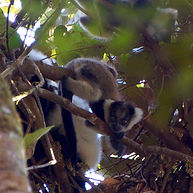RESEARCH INTERESTS
As a Biological Anthropologist with research interests in primate behavior, ecology, and evolutionary biology, I believe that it is important to address research questions using an interdisciplinary and collaborative approach. In this light, I combine traditional fieldwork and laboratory techniques to answer larger evolutionary questions related to primate social and reproductive strategies.
At present, members of my lab focus on two main avenues of inquiry:
-
How landscape features – past, present, and future – influence patterns of distribution, migration, and genetic diversity in wild primate populations; and
-
How the resulting patterns of genetic relatedness within populations and groups can help us to explain the evolution and maintenance of complex social behaviors.
POPULATION & LANDSCAPE GENETICS



Madagascar is routinely identified as a global conservation priority because of its unique biota. Since the 1950s, more than half of Madagascar’s remaining forest cover has been cleared and forest edges have quadrupled (Harper et al. 2007). In fact, some authorities estimate as much as 85-90% of primary vegetation has already been lost (e.g., Myers et al. 2000). Land use practices including logging, mining, and slash and burn agriculture (tavy) continue to threaten Madagascar’s unique flora and fauna.
Lemurs are at particular risk. In fact, the IUCN recently named lemurs the world's most endangered mammals (IUCN 2013). Currently 93 of 103 lemur taxa (90%) are classified as at least Vulnerable and the number of species listed as Critically Endangered (i.e., at extremely high risk of extinction in the wild) has tripled since 2008 (Schwitzer et al. 2013). Understanding the genetic structure of these threatened populations, particularly those that exist in degraded or fragmented habitats, has become an urgent priority for conservation efforts (Schwartz et al. 2006; Frankham 2010).
The lab's current projects investigate the landscape genetics of black-and-white ruffed lemurs (Varecia variegata) at local (Holmes et al. 2013), regional (Mancini et al. 2023), and range-wide scales (Baden et al. 2014, 2019); the population genetics and underlying genetic structure of red-bellied lemurs (Eulemur rubriventer) in Ranomafana National Park (with Drs. Stacey Tecot, Univ. Arizona & Rachel Jacobs, USFWS); the landscape genetics of brown lemurs in northwestern Madagascar (with graduate student Fernando Mercado Malabet and Dr. Shawn Lehman, Univ. Toronto); and the population and landscape genetics of diurnal lemurs throughout the Andasibe-Mantadia landscape (with PMEL graduate student Aparna Chandrashekar and Drs. Kim Valenta, Univ. Florida and Abigail Ross).
EVOLUTION OF LEMUR SOCIAL & REPRODUCTIVE STRATEGIES
Our ongoing studies of genetic structure and gene flow have allowed members of our lab to infer dispersal biases and estimate genetic relatedness among individuals within their respective social communities. This has, in turn, allowed us to use tools in molecular ecology to investigate the evolution and maintenance of complex social behaviors.
Our research currently focuses on two main aspects of lemur social complexity: allomaternal care & behavioral flexibility.
ALLOMATERNAL CARE
Ruffed lemur communal breeding
Communal nesting, where several mothers regularly pool and cooperatively rear offspring, is unusual in mammals, particularly primates. In previous work, I have found that communal care is facultative; not all mothers participate in communal crèches, but those that do have greater maternal success (Baden et al. 2013). Further, it appears that ruffed lemurs preferentially build and use communal nests that are in close proximity to preferred food resources (Baden 2019). My ongoing work continues to study these behaviors in wild ruffed lemurs to address questions of how a female's physical (climate, resource availability) and social environments (strength of social bonds, presence of kin) interact with physiological cues (energy balance, social and/or energetic stress) to regulate and promote these behaviors.

Red-bellied lemur allomaternal care
Since 2013, Dr. Stacey Tecot (Univ. Arizona) and I have been using a unique combination of molecular, endocrine, and observational data to investigate how wild red-bellied lemur (Eulemur rubriventer) individuals are shaped into allomaternal helpers. Our research is directed at identifying 1) the pressures that select for shared infant care behaviors, 2) the mechanisms promoting and maintaining such behaviors in paternal and alloparental helpers, and 3) the adaptive benefits of allomaternal care to mothers who allow others to help.

BEHAVIORAL FLEXIBILITY



Flexibility & fission-fusion dynamics
Fission-fusion dynamics, the fluid, spatiotemporal variation in a species' group size, composition and cohesion, is a rare and unusual social strategy employed by some mammals to cope with fluctuations in resource abundance within a given habitat. Though typically only thought to occur in some anthropoids (e.g., chimpanzees and spider monkeys), this social strategy is more common among primates than originally thought (Aureli et al. 2008).
In a series of manucripts, my colleague Dr. Timothy Webster (Univ. Utah) & and I use social network analyses to investigate spatiotemporal patterns of social association in ruffed lemurs (Varecia variegata), a species that exhibits a much higher degree of fission-fusion dynamics than other lemurs.
Our work has focused on characterizing ruffed lemur fission-fusion dynamics (Baden et al. 2016); quantifying social bonds via network analysis (Baden & Webster 2016, in prep); and asking whether and how associations are related to inter-individual patterns of spatial ecology and kinship (Baden et al. 2014, 2020).
Flexibility & anthropogenic disturbance
Further, PMEL graduate student Nina Beeby and I are investigating behavioral flexibility as it relates to anthropogenic habitat disturbance. Through a series of manuscripts, we document differences in ruffed lemur range use and social dynamics (Beeby et al. in prep), nutrient intake (Beeby et al. in prep), and energy balance (Beeby et al. in prep) in adjacent primary (Mangevo) and secondary (Talatakely) rainforest environments to address whether and how behavioral flexibility might allow ruffed lemurs to cope with environmental degradation.